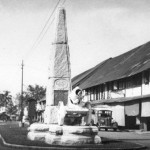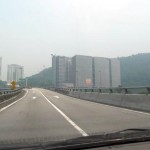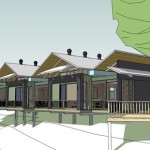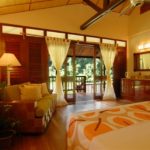Cultural Conditioning
I have had a number of air-conditioning related comments to my last blog post, so I feel the need to try to explain myself a bit better. The following critique could be aimed at any country and discusses cultural aspirations for the built environment.In many cases these aspirations lead to inappropriate use of materials and technology with scant regard for sense of place or community. This is represented in Sabah by gridiron rows of concrete air conditioned boxes with mirrored glass windows and faux stone columns.
Often the stylistic aspiration comes from perceptions of what a modern developed country should look like. It’s a delicate exercise telling someone that their new office building should not look like a Dallas mansion and that instead it should respond to the regional environment in a similar way that local traditional buildings are a response to their culture, materials and climate. The paradox is that in a developing country these traditional buildings represent the subsistence agriculture that they want to move on from. In their rush to embrace the ‘new technologies’ of air conditioning and tinted glass they forget basic considerations such as orientation and sun shading that were intrinsic to traditional buildings.
Air conditioning is not automatically a bad thing, but it is when used as a panacea for poor thermal and solar design. My point is that it’s possible to reduce the reliance on air conditioning through simple methods such as orientation, shading and insulation. If this point can be made successfully then other interesting things can also start to happen, like connection between the building and its environment. By that I mean for example; that natural east and west light is allowed to illuminate breakfast and dinner respectively, that fresh air be allowed into the building to remind you that it’s just stopped raining outside and that you can still look at the view through clear glass and accurately judge what time of day it is.
To complete the circle I’ll come back to an observation that many local people do not like to sit on the veranda and look at the view. They’d prefer to sit in a dark, air conditioned box watching Sky TV. I’m not sure why there is a pervasive culture of turning your back on the environment, Perhaps it has something to do with the speed at which Sabah has been developing over the last couple of decades. The attitude still persists that the forest is either to be feared or overcome.
Unfortunately new technologies mean that the relationship with the forest is not as sustainable as it once was. As a metaphor; one of my clients explains that most people can still remember wrapping their rice cake packed lunch in a leaf. They still eat rice cake packed lunches but now it is wrapped in plastic. There is a big difference between throwing away a leaf and throwing away plastic.
Luckily there is a growing culture of environmental awareness and people placing a recreational value on nature. You only need to look at the number of locals heading out to enjoy the cool climate of Kinabalu Park at the weekend to see this in action. With this should follow a greater pride in the natural and cultural heritage of the country and a will to conserve it. I’m hoping that more environmentally responsive buildings will start to become part of this heritage.
Related Posts






Unfortunately this phenomenum is happening in several eastern countries, which on their rush for development look to replicate the image of the “modern” western cities without further evaluation.
Ignorance and assumptions foster these misunderstood “modern” aesthetic without a consideration for the “genious loci”. Articles like yours are the best way to open the eyes of the well-intentioned but confused fellow.
Pingback: Arkitrek » Blog Archive » New Lab for Danum Valley